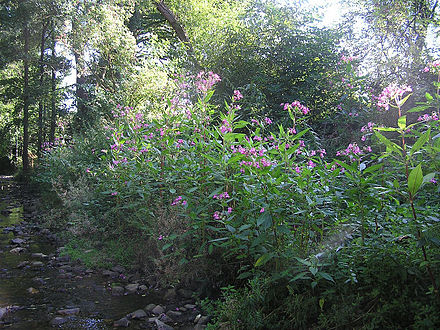Impatiens
Impatiens /ɪmˈpeɪʃəns/[2] is a genus of more than 1,000 species of flowering plants, widely distributed throughout the Northern Hemisphere and the tropics. Together with the genus Hydrocera (one species), Impatiens make up the family Balsaminaceae.
Common names in North America include impatiens, jewelweed, touch-me-not, snapweed and patience. As a rule-of-thumb, "jewelweed" is used exclusively for Nearctic species, and balsam is usually applied to tropical species. In the British Isles by far the most common names are impatiens and busy lizzie, especially for the many varieties, hybrids and cultivars involving Impatiens walleriana.[3] "Busy lizzie" is also found in the American literature. The invasive alien Impatiens glandulifera is commonly called policeman's helmet in the UK.[4]
Most Impatiens species are herbaceous annuals or perennials with succulent stems. Only a few woody species exist. Plant size varies dependent of the species from five centimetres to 2.5 meters. Stems are often rooting when becoming in contact with the soil. The leaves are entire, often dentate or sinuate with extra floral nectaries. Depending on species, leaves can be thin to succulent. Particularly on the underside of the leaves, tiny air bubbles are trapped over and under the leaf surface, giving them a silvery sheen that becomes pronounced when they are held under water.
The zygomorphic flowers of Impatiens are protandric (male becoming female with age). The calyx consists of five free sepals, of which one pair is often strongly reduced. The non-paired sepal forms a flower spur producing nectar. In a group of species from Madagascar the spur is completely lacking, but they still have three sepals. The crown consists of five petals, of which the lateral pairs are fused. The five stamens are fused and form a cap over the ovary, which falls off after the male phase. After the stamens have fallen off, the female phase starts and the stigma becomes receptive, which reduces self-pollination.
The scientific name Impatiens (Latin for "impatient") and the common name "touch-me-not" refer to the explosive dehiscence of the seed capsules. The mature capsules burst, sending seeds up to several meters away.
The genus Impatiens occurs in Africa, Eurasia and North America. Two species (Impatiens turrialbana and Impatiens mexicana) occur in isolated areas in Central America (southern Mexico and Costa Rica). Most Impatiens species occur in the tropical and subtropical mountain forests in Africa, Madagascar, the Himalayas, the Western Ghats (southwest India) and southeast Asia.[5] In Europe only a single Impatiens species (Impatiens noli-tangere) occurs naturally. However, several neophytic species exist.






